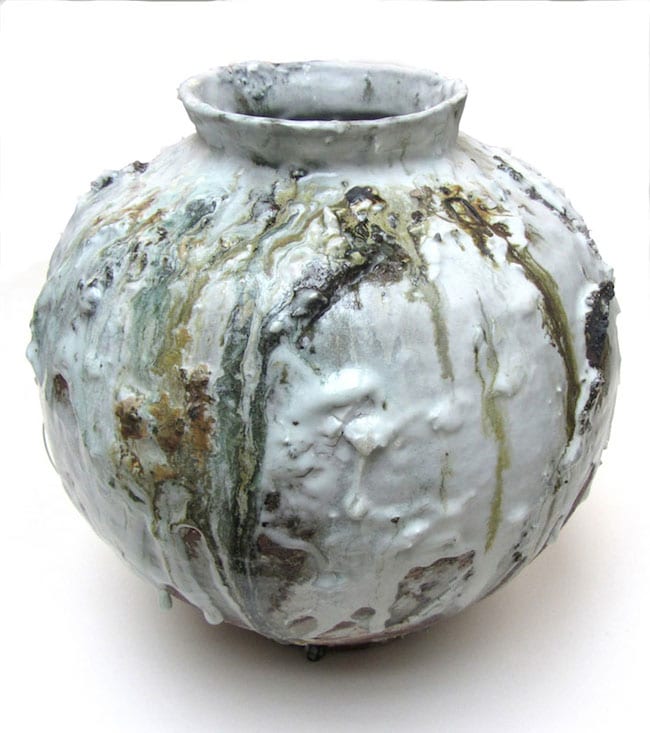Potters are charlatans, according to Webster, “making usually showy pretenses to knowledge or ability.” I should know because I am one, and so, I do not begrudge potters their pretense. I only fault them any claims to the contrary, any claims to authenticity beyond what any other artists can rightfully claim. All artists are charlatans, potters included, dazzling viewers by bedazzling the work with apparent skill, with virtuosity, whether technical or conceptual, overly complex verbiage, or with interdisciplinariousness.
Amidst the acreage of brilliant sensory overload at SOFA (Chicago November 6-9, 2014, there are some true magicians.
Above image: Akiko Hirai, White Moon Jar, 2011, courtesy of Flow, London. Photograph by Toshiko Hirai.
Mindy Solomon can be counted on to present the potters’ potters from the fetishists of the wood fired local clay crowd (yes, I share that kink) to the dearly beloved and recently deceased Kirk Mangus, with some departures from that spectrum in the work of Lauren Mabry. Akiko Hirai makes compelling work inspired by Korean moon jars, straddling that culture’s reverence of tradition and Gareth Mason-esque “ceramics-baroque” surface, represented by Flow Gallery. In the work of Marit Tingleff, Galeri Format presents the most compelling of the “functional art” in ceramics with two gigantic terra cotta serving trays-cum-DeKooning-does-Turner landscapes. Think Norwegian accent, “Yes they are very heavy”, the gallery assistant assured one viewer of the table-sized works and, to be clear, they could serve as the table top. The same assistant goes on to say that the artist does use them to serve food, a pleasing twist. Their scale is a gesture of ostentation, but also one of generosity, of hospitality. They are a radical version of the relational esthetic that potters have always assumed implicit to culinary ceramics, an esthetic that is typically subsumed by knick-knack-ness unless countered by new context, like requiring four people to lift the piece even before it is laden with food.

Lauren Mabry, Vessl, 2013. Courtesy of Mindy Solomon Gallery, Miami.
While all of the above bear mention, one artist’s work in clay made me feel naked without my laptop, and upon grasping the scope of the work, leaving immediately to begin writing crossed my mind. Bae Se Jin’s En attendant Godot (Waiting for Godot) achieves an intellectual and cultural layering in its traditional “craft materials as nature” approach to a pivotal piece of Western literature. Bae’s craftsmanship and patience, if not absurd obstinacy, rise into the walls of a vessel constructed of thousands of small paperclay slabs. The clay is paired with work on paper in the form of printed numbers. Upon first glance the work appears to be somehow industrially extruded, digitally enhanced, 3D printed, CNC milled or in some way not of this analog world— a minor curiosity.

Bae Se Jin, from the “Waiting for Godot” series. Courtesy of Korea Crafts and Design Foundation.
With attention, however, comes discernment of a distinctly non-digital pattern. Bae serially numbers every piece of clay he uses and stamps its number into the clay as he works. Next to or below the ceramics are the clues to this pattern: the same numbers stamped on paper. His strategy places him as an escapee of playwright Samuel Beckett’s purgatory, detailed in the script from which Bae’s works take their title. Bae’s upward spiral, through the obsessive numbering of its constituent parts, allows him to mark time and so to ascend from depths of timeless forgetfulness, declining to wait for the arrival of a muse, a patron, a savior. Bae performs such a thorough mastication of Beckett’s work that one wonders whether the paper in the paper clay Bae used might have been from one of Beckett’s physical scripts. Godot may or may not have attended SOFA Chicago 2014, but for several moments Bae’s work freed me from the anxiety of waiting for him.
Jordan Taylor is a sculptor, potter and writer based in Chicago.
Any thoughts about this post? Share yours in the comment box below.



Marit Tingleff, Panorama I and II. Courtesy of Galeri Format, Oslo.






Bae Se Jin, from the “Waiting for Godot” series.

Add your valued opinion to this post.